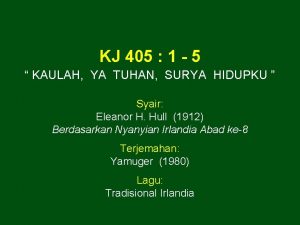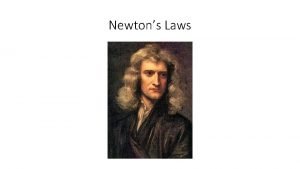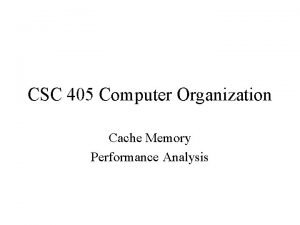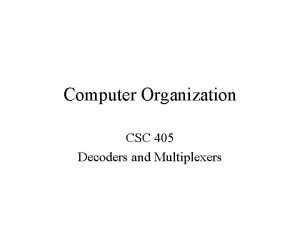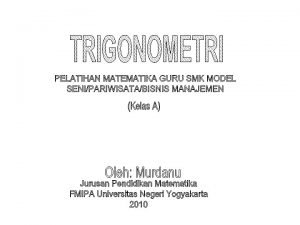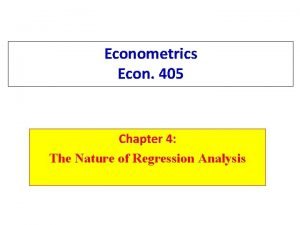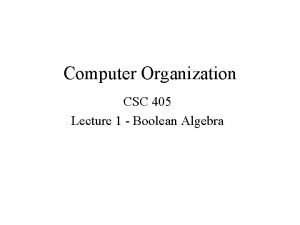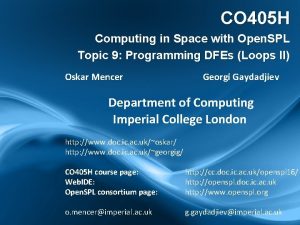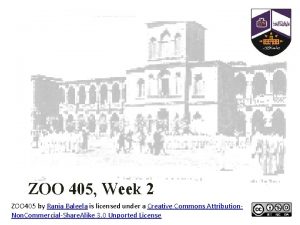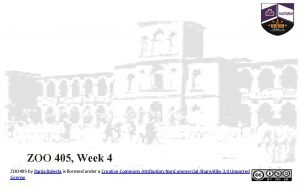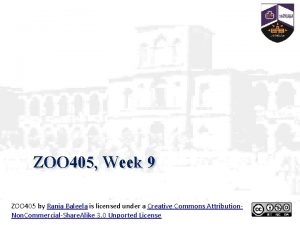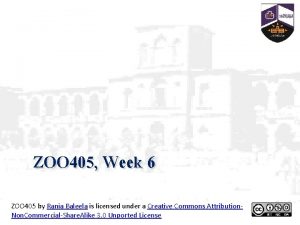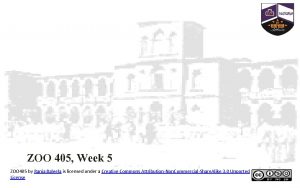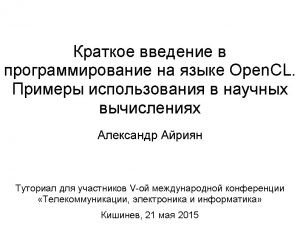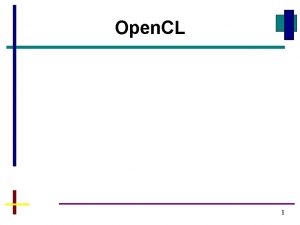CO 405 H Computing in Space with Open









![Multiple Loops: n-Body problem […] // all DFEVar DFEVar the below are interleaved data Multiple Loops: n-Body problem […] // all DFEVar DFEVar the below are interleaved data](https://slidetodoc.com/presentation_image_h2/61fbde243eb3bb313ceb949418104192/image-10.jpg)


![input[0, 0], input[0, 1], input[0, 2]. . . 1 0. 0 2 3 4 input[0, 0], input[0, 1], input[0, 2]. . . 1 0. 0 2 3 4](https://slidetodoc.com/presentation_image_h2/61fbde243eb3bb313ceb949418104192/image-13.jpg)
![Pipeline Depth and Loop-Carry Distance for (i=0; i<N; i++){ for (j=0; j<M; j++) v[i]=v[i]*v[i]+1; Pipeline Depth and Loop-Carry Distance for (i=0; i<N; i++){ for (j=0; j<M; j++) v[i]=v[i]*v[i]+1;](https://slidetodoc.com/presentation_image_h2/61fbde243eb3bb313ceb949418104192/image-14.jpg)




- Slides: 18

CO 405 H Computing in Space with Open. SPL Topic 9: Programming DFEs (Loops II) Oskar Mencer special thanks: Jacob Bower Georgi Gaydadjiev Department of Computing Imperial College London http: //www. doc. ic. ac. uk/~oskar/ http: //www. doc. ic. ac. uk/~georgig/ CO 405 H course page: Web. IDE: Open. SPL consortium page: http: //cc. doc. ic. ac. uk/openspl 14/ http: //openspl. doc. ic. ac. uk http: //www. openspl. org o. mencer@imperial. ac. uk g. gaydadjiev@imperial. ac. uk

From Loops I: Loop Nest without Dependence int count = 0; for (int i=0; i<N; ++i) { for (int j=0; j<M; ++j) { B[count] = A[count]+(i*M)+j; count += 1; } } DFEVar A = io. input(”input” , dfe. UInt(32)); Counter. Chain chain = control. count. make. Counter. Chain(); DFEVar i = chain. add. Counter(N, 1). cast(dfe. UInt(32)); DFEVar j = chain. add. Counter(M, 1). cast(dfe. UInt(32)); DFEVar B = A + i*100 + j; io. output(”output” , B , dfe. UInt(32)); 2 i 100 j A + + * Use a chain of counters to generate i and j B

Loop Unrolling with Dependence for (i = 0; ; i += 1) { float d = input[i]; float v = 2. 91 – 2. 0*d; for (iter=0; iter < 4; iter += 1) v = v * (2. 0 - d * v); output[i] = v; } DFEVar d = io. input(”d”, dfe. Float(8, 24)); DFEVar TWO= constant. var(dfe. Float(8, 24), 2. 0); DFEVar v = constant. var(dfe. Float(8, 24), 2. 91) − TWO*d; for ( int iteration = 0; iteration < 4; iteration += 1) { v = v*(TWO− d*v); } io. output(”output” , v, dfe. Float(8, 24)); 3

Overview of Spatializing Loops • Classifying Loops – Attributes and measures • Simple Fixed Length Stream Loops – Example vector add – Custom memory controllers • Nested Loops – Counter chains – Streaming and unrolling – How to avoid cyclic graphs • Variable Length Loops – Convert to fixed length • Loops with data dependencies – DFESeq. Loop: with a data parallel streaming loop – DFEPar. Loop: with a sequential streaming loop 4

DFESeq. Loop: Data Parallel Streaming Loop Instead of unrolling, create a sequential inner loop to save space => resource sharing Assume 4 stages implement 1 multiply * <Click to advance> square in 4 3 2 1 lp 1. feedback for i=1 to N // data parallel loop in = stream_in[i]; for j=1 to 2 { // sequential loop lp 1 square = in * in; in = square; // feedback } stream_out[i] = square; lp 1. itr 1 lp 1. done DFESeq. Loop lp 1= new DFESeq. Loop(this, “lp 1”, 2); DFEVar in = io. input("in", dfe. Float(8, 24), lp 1. itr 1); lp 1. set_input(in); DFEVar square = lp 1. feedback * lp 1. feedback; lp 1. set_output(square); io. output(”square", square, dfe. Float(8, 24), lp 1. done);

DFEPar. Loop: Sequential Streaming Loop Simple Accumulator Example (actually 4 concurrent accumulators) interleaved(4) stream_in lp 2. ndone interleaved(4) result lp 2. done CPU code, SAPI. h: get loop size: mget_loop. Length() returns 4 lp 2. feedback DFEPar. Loop lp 2 = new DFEPar. Loop(this, “lp 2”); for j=1 to 4: out[j]=0. 0; for i=1 to N: // sequential loop for j=1 to 4: // data parallel loop out[j] = out[j]+stream_in[i]; Of course j could be a lot larger, but we do 4 at a time here since we assume 4 stages in a Adder (Accumulator) assuming 4 pipeline stages DFEVar in = io. input("in", dfe. Float(8, 24), lp 2. ndone); lp 2. set_input(dfe. Float(8, 24), 0. 0); + DFEVar result = in + lp 2. feedback; lp 2. set_output(result); io. output(”result", result, dfe. Float(8, 24), lp 2. done);

DFESeq. Loop details (optional) class DFESeq. Loop extends Kernel. Lib { DFEVar itr 1, done, feedback, feed_in; Offset. Expr loop; DFESeq. Loop(Kernel owner, String loop_name, int loop_itrs) { super(owner); loop = stream. make. Offset. Auto. Loop(loop_name); DFEVar pipe_len = loop. get. DFEVar(this, dfe. UInt(32)); DFEVar global_pos = control. count. simple. Counter(32); itr 1 = global_pos < pipe_len; done = global_pos >= (pipe_len * loop_itrs); } DFESeq. Loop lp 1= new DFESeq. Loop(this, “lp 1”, 2); DFEVar in = io. input("in", dfe. Float(8, 24), lp 1. itr 1); lp 1. set_input(in); DFEVar square = lp 1. feedback * lp 1. feedback; lp 1. set_output(square); io. output(”square", square, dfe. Float(8, 24), lp 1. done); void set_input(DFEVar loop_in) { feed_in = loop_in. get. Type(). new. Instance(this); feedback = itr 1 ? feed_in : loop_in; // feed_in in the first iteration } void set_output(DFEVar result) { feed_in <== stream. offset(result, -loop); // connect the loop } } 7

DFEPar. Loop details (optional) class DFEPar. Loop extends Kernel. Lib { DFEVar feed_in, pipe_len, global_pos, feedback, done, ndone; Offset. Expr loop; DFEPar. Loop(Kernel owner, String loop_name) { super(owner); loop = stream. make. Offset. Auto. Loop(loop_name); pipe_len = loop. get. DFEVar(this, dfe. UInt(32)); // Par. Loop iterates as long as there is data DFEVar stream_len = io. scalar. Input(loop_name + "_len", dfe. UInt(32)); global_pos = control. count. simple. Counter(32); done = global_pos >= (stream_len + pipe_len); ndone = global_pos < stream_len; DFEPar. Loop lp 2 = new DFEPar. Loop(this, “lp 2”); } DFEVar in = io. input("in", dfe. Float(8, 24), lp 2. ndone); lp 2. set_input(dfe. Float(8, 24), 0. 0); DFEVar result = lp 2. feedback + in; lp 2. set_output(result); io. output(”result", result, dfe. Float(8, 24), lp 2. done); void set_input(DFEType fb_type, double init) { feed_in = fb_type. new. Instance(this); DFEVar start_feedback = global_pos < pipe_len; feedback = start_feedback ? feed_in : init; } void set_output(DFEVar result) { feed_in <== stream. offset(result, -loop); // connect the loop } 8

Data Loops need Cyclic (Round Robin) interleaved Data DFEVar streams interleave(4) 4 3 2 1 de-interleave(4) Conversion can be done at runtime on the CPU in Software or on the DFE as Dataflow OR interleaving and de-interleaving can be pre-computed and stored in memory
![Multiple Loops nBody problem all DFEVar DFEVar the below are interleaved data Multiple Loops: n-Body problem […] // all DFEVar DFEVar the below are interleaved data](https://slidetodoc.com/presentation_image_h2/61fbde243eb3bb313ceb949418104192/image-10.jpg)
Multiple Loops: n-Body problem […] // all DFEVar DFEVar the below are interleaved data streams rx = pj. X - pi. X; ry = pj. Y - pi. Y; rz = pj. Z - pi. Z; dd = rx*rx + ry*ry + rz*rz + scalars. EPS; d = 1 / (dd * Kernel. Math. sqrt(dd)); s = pj. M * d; DFEPar. Loop lp = new DFEPar. Loop(this, “lp”); lp. set_inputs(3, dfe. Float(8, 24), 0. 0); DFEVar acc. X = lp. feedback[0] + rx*s; DFEVar acc. Y = lp. feedback[1] + ry*s; DFEVar acc. Z = lp. feedback[2] + rz*s; lp. set_outputs(acc. X, acc. Y, acc. Z); […]

Ok, so how does this really work… int count = 0; for (int i=0; ; i += 1) { sum[i] = 0. 0; for (int j=0; j<M; j += 1) { sum[i] = sum[i] + input[count]; count += 1; } output[i] = sum[i]; } DFEVar Loop. Count = control. count. simple. Counter(32, M); DFEVar carry = scalar. Type. new. Instance(this); DFEVar sum = Loop. Count. eq(0) ? 0. 0 : carry; sum = input + sum; carry. connect(stream. offset(sum, − 13)); // feedback fifo buffer io. output(”output” , sum, scalar. Type, Loop. Count. eq(M − 1)); 11 -13

Pipeline Depth, Why -13 The multiplexer has a pipeline depth of 1 The floating-point adder has a pipeline depth of 12 Total loop latency = 13 ticks, carry. connect(stream. offset(sum, − 13)); luckily stream. make. Offset. Auto. Loop() figures out the loop length for us. Now on the software side we need to interleave the input stream with a stride of 13. CPU call: get_loop. Length() Generated by the compiler for every loop in the Kernel will return 13! See SAPI. h interface… 12 -13
![input0 0 input0 1 input0 2 1 0 0 2 3 4 input[0, 0], input[0, 1], input[0, 2]. . . 1 0. 0 2 3 4](https://slidetodoc.com/presentation_image_h2/61fbde243eb3bb313ceb949418104192/image-13.jpg)
input[0, 0], input[0, 1], input[0, 2]. . . 1 0. 0 2 3 4 5 6 7 8 9 Output[0] 10 11 12 13 9 10 11 12 13 8 9 10 11 12 • input[1, 0], input[1, 1], input[1, 2]. . . 1 0. 0 2 3 4 5 6 7 8 Output[1] • input[2, 0], input[2, 1], input[2, 2]. . . 1 0. 0 2 3 4 5 6 7 After an initial pipeline fill phase, all 13 pipeline stages are occupied 13 independent summations are computed in parallel Output[2] input[3, 0], input[3, 1], input[3, 2]. . . 0. 0 1 2 time 3 4 5 6 7 13 Output[3]
![Pipeline Depth and LoopCarry Distance for i0 iN i for j0 jM j vivivi1 Pipeline Depth and Loop-Carry Distance for (i=0; i<N; i++){ for (j=0; j<M; j++) v[i]=v[i]*v[i]+1;](https://slidetodoc.com/presentation_image_h2/61fbde243eb3bb313ceb949418104192/image-14.jpg)
Pipeline Depth and Loop-Carry Distance for (i=0; i<N; i++){ for (j=0; j<M; j++) v[i]=v[i]*v[i]+1; // distance 1 } Now the j-loop has a loop-carried dependency with distance 1, i. e. each loop needs the v[i] result of the previous loop, BUT the v[i]*v[i]+1 operations have X stages and thus take X clock cycles. for (i=0; i<N/X; i++){ for (j=0; j<M; j++) for (k=0; k<X; k++) // distance X v[i*X+k]=v[i*X+k]*v[i*X+k]+1; } 14 X Note that v[i]s are independent, i. e. the i-loop has no dependency! Þ We thus need X activities (v[i]s) to be in the loop at all times to fully utilize all stages of the multiplication pipeline.

Computing with 2 D Arrays: Loop interchange 15 • Example: Row-wise summation is serial due to chain of dependence • Column-wise summation would be easy of course • So we can keep the pipeline in a cyclic datapath full by flipping the problem – ie by interchanging the loops

Loop Tiling reduces FMEM requirement • Idea: sum a block of rows at a time (“tiling”) • We can choose the tile size • Just big enough to fill the pipeline • so no unnecessary buffering is needed • c is the length of the feedback loop, depending on the number format for the accumulator! 16

Loop Tiling reduces FMEM requirement What if we need a particular loop length because of the particular size of our matrix? We can set loop. Length to any number larger than the minimum Loop. Length: DFEPar. Loop lp 2 = new DFEPar. Loop(this, “lp 2”); DFEVar in = io. input("in", dfe. Float(8, 24), lp 2. ndone); lp 2. set_input(dfe. Float(8, 24), 0. 0); DFEVar result = lp 2. feedback + in; lp 2. set_output(result, 16); // set loop. Length to 16 io. output(”result", result, dfe. Float(8, 24), lp 2. done); However, the larger the loop. Length, the more resources are needed globally. Therefore, for maximal efficiency, loop. Length should be as small as possible… 17

Summary: Feedback Loops for Computing in Space • If an unrolled loop does not fit => DFESeq. Loop • For a loop with a loop-carried data dependence which cannot be unrolled, we need to create a loop in the data flow graph => DFEPar. Loop • Interchanging loops and reorganising computations can reduce resource requirements • Splitting loops into blocks (“tiling”) allows us to control the amount of buffering required 18
 Open innovation open science open to the world
Open innovation open science open to the world 405 field hospital
405 field hospital Lan 405
Lan 405 Kj405
Kj405 David rockefeller memoirs page 405
David rockefeller memoirs page 405 Lan 405
Lan 405 405 000 in scientific notation
405 000 in scientific notation A basketball star exerts a force of 3225
A basketball star exerts a force of 3225 Adq 405 getnet
Adq 405 getnet How to calculate upper bound
How to calculate upper bound Csc 405
Csc 405 Csc 405
Csc 405 Carilah nilai perbandingan trigonometri
Carilah nilai perbandingan trigonometri Dr joanne fox
Dr joanne fox U
U Prf in econometrics
Prf in econometrics Csc 405
Csc 405 Conventional computing and intelligent computing
Conventional computing and intelligent computing Open edge computing initiative
Open edge computing initiative



